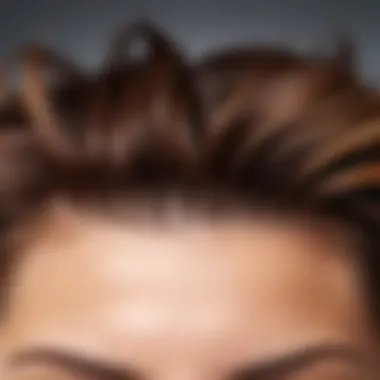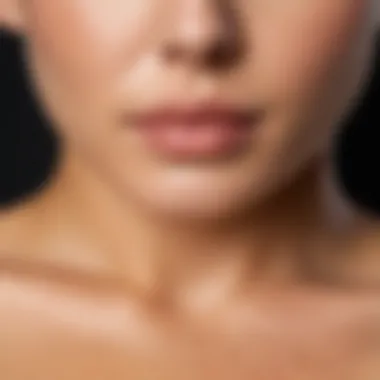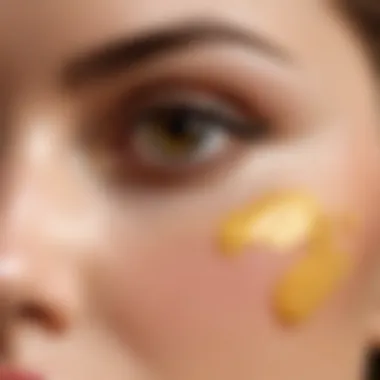Mastering Waxing: The Importance of Application Direction


Intro
Waxing is more than a simple hair removal technique; it is an art that requires precision, especially when considering the direction of application. Understanding how hair grows and how it should be waxed can deeply influence the effectiveness of the process. Missteps in this area can lead to discomfort, missed hairs, and a less satisfactory outcome. Through this guide, we will dissect the pivotal elements of waxing application techniques. This exploration will serve both seasoned practitioners and newcomers seeking to enhance their hair removal routine.
Ürün İncelemesi
When discussing waxing, the products employed play a significant role in the overall experience. The choice of wax can vary widely depending on individual preferences and specific skin types. Here, we examine the various types of waxing products available and their unique features.
Ürün Tanıtımı
Several brands dominate the waxing market. Among them are Hard Wax Beans, which are excellent for sensitive areas, and Soft Wax, preferred for larger body zones. While Hard Wax is typically applied directly to the skin and removed without strips, Soft Wax requires strips for removal, making it versatile yet sometimes less efficient for stubborn hair.
Ürün Özellikleri
- Hard Wax: Suitable for sensitive skin; it adheres to the hair but not to the skin, reducing discomfort.
- Soft Wax: Effective on larger areas; it requires strips and can pull at the skin, leading to redness.
- Sugar Wax: Made from natural ingredients; it is gentler and can be washed off with water, appealing for those seeking organic options.
Each type of wax has its own application method, and mastering these can lead to a more successful waxing session.
Güzellik İpuçları
Achieving the perfect wax isn't solely about techniques but also involves preparation for the skin and body. Before waxing, it's vital to follow certain beauty tips to ensure a smoother experience.
Doğal Güzellik Yöntemleri
- Exfoliation: Gently scrub the skin 24 hours prior to waxing. This will help remove dead skin cells and prevent ingrown hairs.
- Moisturizing: Use a light moisturizer to keep skin hydrated but avoid heavy oils that can impede wax adherence.
- Avoiding Sun Exposure: Stay out of the sun a few days before your waxing appointment to minimize skin sensitivity.
Sağlıklı Beslenme ve Güzellik
Nutrition also plays a role in skin health. Consuming foods rich in vitamins A, C, and E can help maintain skin elasticity and overall health. Consider incorporating:
- Fruits and Vegetables: High in antioxidants and vitamins.
- Omega-3 Fatty Acids: Found in fish and nuts; they enhance skin hydration.
- Hydration: Drink plenty of water to keep skin supple and ready for waxing.
"The right preparation can significantly enhance waxing outcomes, minimize irritation, and lead to longer-lasting results."
Prolusion to Waxing
Understanding the art of waxing can significantly enhance one’s hair removal experience. The techniques used in waxing are not just about pulling any hair; they require a thoughtful approach and knowledge of skin and hair dynamics. Waxing, as a method, offers benefits like longer results compared to shaving and a smoother finish. With this guide, readers can appreciate the nuances of effective application and learn how to optimize their routines for best results.
Definition and Overview
Waxing is a method of hair removal that involves applying a sticky substance or wax to the skin, adhering to the hair, and then quickly removing it, along with the hair. This process pulls hair from the root, leading to smoother skin for an extended period compared to other methods like shaving. The type of wax, the technique used, and the skin condition can all affect the results. Getting the direction of application correct is critical for minimizing discomfort and improving effectiveness.
History of Waxing Practices
The practice of waxing can be traced back thousands of years. Ancient civilizations, including the Egyptians, used natural substances like sugar and resin to remove hair. As cultures evolved, waxing techniques were refined and varied. Today, the etiquette and methods vary around the globe, influenced by trends, regional practices, and product advancements. Understanding the historical context can shed light on why certain techniques are employed today.
Types of Waxing
Waxing comes in various forms, each with distinct features and applications. Knowing these types can help individuals choose the right method for their needs.
Hard Wax
Hard wax is applied warm to the skin and hardens without the need for strips. This type of wax is suitable for sensitive areas. Its excellent grip allows for a cleaner removal, which reduces pain. Hard wax is praised for being less irritating, making it a popular choice for many.
Advantages of hard wax include:
- Minimal skin irritation: It only adheres to hair and not the skin, making it gentler.
- Easier on sensitive areas: Perfect for areas like the bikini region or armpits.
- For various hair types: Works well for coarse and fine hair.
Disadvantages can include:
- Longer application time: As it must be allowed to harden before removal.
Soft Wax


Soft wax is more versatile and is applied in a thin layer over the skin. A strip is then placed over the wax and swiftly removed to pull hair from the roots. This wax is effective for larger areas.
Key features of soft wax include:
- Efficiency: Covers larger surface areas, making it quicker for legs or arms.
- Cost-effective: Often less expensive than hard wax options.
However, soft wax can be more irritating because it adheres to the skin. Advantages and disadvantages should be carefully considered when deciding between soft and hard wax.
Strip Wax
Strip wax is essentially a subtype of soft wax and requires special cloth or paper strips for removal. This method is widely used in salons and is particularly favored for its speed and ease.
Highlighting its characteristics:
- Convenience: Ideal for quick sessions, commonly used in salon settings.
- Good for experienced users: Best suited for individuals familiar with the process.
Nevertheless, it comes with some drawbacks:
- Higher potential for irritation: May cause more discomfort on sensitive skin.
Understanding these different types of waxing lays a foundation for the subsequent sections that will address application direction, which is crucial for effective outcomes.
Understanding Hair Growth Patterns
Understanding hair growth patterns is key for effective waxing. Each individual's hair has a unique growth cycle and direction. Recognizing these aspects enhances the outcome of waxing sessions. Moreover, knowledge on hair direction helps to minimize discomfort and improve hair removal efficiency. For optimal results, consideration of specific body areas is essential.
Anatomy of Hair Growth
Hair grows from follicles located beneath the skin's surface. Each follicle is responsible for producing a single hair strand. The growth of hair occurs in cycles: anagen (growth), catagen (transitional), and telogen (resting). During the anagen phase, the hair is actively growing and tends to be longer and stronger. The catagen phase involves hair stopping its growth and detaching from the follicle. Finally, in the telogen phase, hair naturally falls out, making way for new growth. Understanding these phases is important for planning effective waxing sessions, as waxing is most effective during the anagen phase.
Growth Direction in Different Body Areas
Facial Hair
Facial hair growth is generally denser and often coarser than body hair. It typically grows in various directions, which can complicate the waxing process. For instance, the hair on the upper lip may grow downward, while cheek hair may grow outward. This variability in growth direction necessitates careful attention during application to avoid missed spots and ensure smooth results. Applying wax against the hair growth direction and pulling alongside or in the same direction can help in effectively removing the hair while minimizing skin irritation.
Underarm Hair
Underarm hair usually grows in a circular pattern, with some hairs growing upwards and others growing downwards. Waxing this area requires a precise application technique due to its shape and sensitivity. The main advantage of waxing underarm hair is that it can result in longer-lasting smoothness compared to shaving. Waxing against the grain of hair growth ensures that most of the hair is removed in one go, reducing the chances of missed spots or inconsistent results.
Bikini Area
The bikini area presents unique challenges due to its sensitive skin and varying hair growth patterns. Hair in this area may grow in multiple directions, making careful application crucial. Waxing the bikini area effectively requires understanding the specific growth direction of hair in various regions, such as the bikini line versus the inner thighs. A key benefit of waxing in this area is the ability to achieve a clean and smooth finish. However, improper application can lead to discomfort and skin irritation, making knowledge of hair growth patterns essential for anyone attempting this type of waxing.
The Importance of Application Direction
Understanding the correct application direction when waxing is critical for achieving not just effective hair removal but also minimizing discomfort and ensuring skin health. The direction in which the wax is applied can have profound implications on the overall success of the waxing technique. It is essential to tailor the application method to the specific area of the body since the hair growth patterns vary widely among different body regions. Not only does accurate direction facilitate smoother hair removal, but it also decreases the likelihood of skin irritation and potential ingrown hairs.
Why Direction Matters
When waxing, applying the wax in the correct direction is directly related to the angle at which hairs grow from the skin. Hair generally grows in a specific direction, and waxing opposite to this growth enhances the effectiveness of the procedure. This method helps in grasping the hair with the wax, ensuring that each hair is effectively pulled from the follicle when the wax strip is removed.
Failure to respect the natural growth direction can lead to several problems:
- Pain and Discomfort: If the wax is pulled in a direction against the hair, it can increase the pain experienced during the removal process.
- Hair Breakage: Incorrect application can cause hair to break instead of being removed at the root, leading to a patchy appearance and requiring more frequent touch-ups.
- Skin Irritation: Pulling the skin in the wrong direction can lead to unnecessary trauma, resulting in redness, swelling, or even bruising.
For these reasons, practitioners, both professional and at-home, should familiarize themselves with the typical hair growth patterns in the areas they are waxing. This awareness is vital for optimizing results and enhancing the waxing experience overall.
Effects of Incorrect Application
Applying wax in the wrong direction can have several negative effects that extend beyond discomfort. Here are the key consequences:
- Suboptimal Hair Removal: Many hairs may remain, necessitating additional waxing sessions or requiring other hair removal methods, like shaving.
- Increased Risk of Ingrown Hairs: When hair is not removed properly, it can grow back into the skin, causing painful ingrown hairs. That's why proper direction is paramount.
- Prolonged Healing Time: Incorrect techniques can lead to skin damage and require waiting for irritation to subside before attempting another waxing session.


It is crucial to acknowledge that with incorrect application techniques, one not only risks an ineffective waxing session but may also influence long-term skin health and appearance. Understanding the importance of waxing direction is an essential takeaway for anyone who desires effective hair removal results.
Step-by-Step Wax Application
Understanding the process of wax application is critical for achieving effective hair removal results. This section breaks down the application into simpler steps, guiding individuals through preparation, application, and removal. Each step contributes significantly not just to the outcome but also to the experience of waxing itself. By following these steps meticulously, one can minimize discomfort and maximize results, providing a smoother skincare routine.
Preparation Steps
Skin Cleansing
Cleansing the skin before waxing is essential. It removes dirt, oil, and impurities that can interfere with the wax's adherence to the hair. The primary benefit of skin cleansing is that it lays a clean canvas for waxing, improving adhesion and ensuring smooth removal of hair. A clean area reduces the risk of irritation and infection, making it a fundamental step in the waxing process. Using gentle cleansers ensures the skin's natural oils remain intact, avoiding dryness that can hinder waxing results.
Exfoliation
Exfoliation helps to prepare the skin by removing dead skin cells, which can lead to ingrown hairs. By smoothing the skin's surface, exfoliation enhances the effectiveness of the waxing process. This step is beneficial because it prevents the hairs from becoming trapped under dead skin and facilitates a cleaner waxing experience. However, over-exfoliating or using harsh products can damage the skin, leading to irritation or sensitivity, so gentleness is crucial.
Testing Wax Temperature
Testing the wax temperature is another vital step. Applying wax that is too hot can cause burns, while wax that is too cold may not adhere well to the hair. It's important to ensure the wax is at a safe and effective temperature for application. This step shows a key characteristic of safety and efficacy, balancing comfort with effectiveness. Additionally, checking the temperature on a less sensitive spot, such as the inside of the wrist, is a simple practice that avoids potential mishaps.
Applying the Wax
Direction of Application
The direction in which wax is applied significantly impacts the effectiveness of hair removal. Applying wax in the same direction as hair growth can sometimes lead to ineffective results, as it may not grip the hair properly. Therefore, wax should ideally be applied against the direction of hair growth. This method allows the wax to envelop the hair more effectively, enhancing removal potential. Knowing the right direction for various body areas, such as legs or underarms, is crucial.
Thickness of Wax Layer
The thickness of the wax layer impacts both adhesion and removal efficacy. A thin, even wax layer is more effective because it can encapsulate the hair properly. If the layer is too thick, it may not adhere properly to the hair and can be more challenging to remove. This consideration makes it crucial in achieving a balance; the correct thickness improves the wax's grip and ensures smoother removal, minimizing discomfort.
Removing the Wax
Proper Technique
Using the right technique for removing wax is essential to prevent pain and ensure hair is removed effectively. A quick, firm pull in the opposite direction of hair growth is the best practice. Adopting this technique reduces the likelihood of breaking the hair, which can cause discomfort and necessitate additional waxing sessions. This straightforward yet effective method reflects on the overall success of the waxing experience.
Following the Hair Growth Direction
Following the natural hair growth direction during removal is particularly important. Doing so aids in complete hair removal and minimizes discomfort. Removing against the direction of growth risks hair breakage, resulting in an uneven finish and potential ingrown hairs. This practice not only contributes to a cleaner result but also enhances the comfort level during the waxing process.
"Effective waxing is more than just a technique; it’s a science that inclues all these vital steps. It is an art form that one can master through practice and understanding."
By meticulously following each step outlined in this section, individuals can expect enhanced results, a more pleasant experience, and healthier skin post-waxing.
Post-Wax Care
After waxing, the care you provide your skin is crucial for optimal results and skin health. Proper post-wax care minimizes irritation, promotes healing, and enhances your skin's appearance. It ensures that the benefits of waxing are preserved over time. Without proper care, adverse reactions can occur, negating the positive effects of the waxing process. Attention to immediate aftercare and long-term skin care will provide the best outcomes for anyone who undergoes waxing.
Immediate Aftercare
Immediate aftercare focuses on the immediate actions taken right after the waxing process. It plays a significant role in soothing the skin and preventing any potential reaction that may arise from waxing.
Cleansing the Area
Cleansing the area after waxing is essential. This step helps to eliminate any remaining wax, bacteria, and impurities from the skin's surface. Cleanliness is key to preventing infections and ensuring a smooth surface post-wax. This process is beneficial as it prepares the skin for further soothing. A gentle, fragrance-free cleanser is preferred to avoid irritation. The unique feature of cleansing is its ability to substantially reduce the risk of breakouts. However, one must be cautious not to use harsh products, as they may worsen sensitivity.
Applying Soothing Products
Applying soothing products is essential for calming the skin after waxing. This step involves the use of creams or lotions designed to reduce redness and inflammation. Soothing products often contain ingredients like aloe vera or chamomile, which help calm irritation and hydrate the skin. They are beneficial because they accelerate the skin's recovery process, allowing for a more comfortable experience post-wax. The unique aspect is that these products also provide a layer of moisture, which can enhance the skin's softness. The disadvantage, however, may be the potential for greasy finishes; thus, selecting the right formulation is crucial.
Long-Term Skin Care
Long-term skin care involves maintaining skin health over time through appropriate routines after waxing. This aspect is essential for sustaining the results achieved through waxing.


Moisturizing
Moisturizing plays a vital role in long-term skin care. Keeping the skin hydrated post-waxing helps prevent dryness and flakiness. A well-moisturized skin barrier promotes regeneration and improves overall appearance. This is why moisturizing is a favorable choice; it maintains skin elasticity and smoothness. The unique feature of moisturizing is the deep hydration it provides, which can reduce the risk of ingrown hairs. However, overly heavy products may lead to a greasy feel, so lighter formulations are often recommended.
Exfoliating
Exfoliating is another critical aspect of long-term skin care that aids in maintaining smooth skin. Regular exfoliation helps to remove dead skin cells, which can otherwise contribute to ingrown hairs following waxing. A beneficial choice, exfoliation enhances skin renewal and can improve texture. The unique feature of exfoliating is its dual role, as it not only smoothens skin but also prepares it for further waxing sessions. The disadvantage is that over-exfoliation can lead to irritation, thus it should be balanced with moisture and not performed too frequently.
Proper post-wax care can significantly improve the experience and outcomes of hair removal practices. Following these guidelines can help individuals maintain their skin's health and ensure lasting results.
Common Waxing Mistakes
Understanding the common mistakes in waxing is essential for achieving optimal results. Often, both novices and experienced individuals can overlook critical aspects of the process. These oversights can lead to unsatisfactory outcomes, skin irritation, or even injury. Awareness of these mistakes allows for better preparation, improved techniques, and ultimately a more enjoyable hair removal experience.
Over-Waxing
Over-waxing occurs when the same area of skin is waxed multiple times during a single session. This action can lead to skin irritation, redness, and in some cases, even burns. It is crucial to limit the number of times the same area is treated.
Proper timing between applications is important. Allowing the skin to recover is vital. When the skin is stripped of hair too many times in one session, it can disrupt the natural barrier, causing sensitivity.
Minimizing over-waxing not only conserves wax but also promotes healthier skin post-wax.
Key considerations to avoid over-waxing include:
- Assess the area thoroughly prior to waxing it multiple times.
- Use soothing products between wax sessions.
- Adhere to guidelines regarding how often to wax each area.
Incorrect Temperature
Using wax at incorrect temperatures is a frequent mistake. If the wax is too hot, it can damage the skin, leading to burns. Conversely, wax that is too cold may not adhere effectively to the hair, leading to ineffective hair removal.
To ensure safe and efficient application, testers should be implemented before applying wax to the desired area. This verification method can be done by:
- Applying a small amount of wax to your wrist or forearm.
- Observing the ease of spread and the warmth sensation.
Remember, different wax types have various recommended temperatures. Always refer to product-specific guidelines for best results. Monitoring wax temperature is critical not only for safety but also for the efficacy of the waxing process.
Not Following Hair Growth Direction
One of the most significant mistakes made in waxing is not applying the wax in the direction of hair growth. This error can result in breakage or incomplete hair removal, leading to increased regrowth time and photo implications for skin health.
When applying wax, take the time to observe the natural growth patterns of the hair in the intended area. Follow these guidelines to ensure that hair removal is as effective as possible:
- Identify the growth direction of hair before starting.
- Apply the wax against the hair growth for adherence.
- Pull the strip or wax off in the direction of hair growth.
By adhering to these principles, one can achieve a smoother finish and reduce the chances of ingrown hairs or irritation.
Professional vs. At-Home Waxing
Choosing between professional and at-home waxing can significantly impact the results and experience of hair removal. Understanding the differences is essential for individuals who want to achieve the best possible results while minimizing discomfort.
Advantages of Professional Waxing
Professional waxing services are often preferred by those seeking a thorough and accommodating hair removal experience. Here are some notable advantages:
- Expertise: Professional aestheticians possess the training and experience to perform waxing efficiently. They understand skin types, hair growth patterns, and the best techniques to use for different body areas.
- Higher Quality Products: Salons frequently use high-quality waxes and pre- and post-waxing products. This can enhance results while reducing skin irritation and allergic reactions.
- Hygiene and Safety: Licensed professionals follow strict hygiene protocols. This reduces the risk of infections or complications arising from improper application.
- Long-Lasting Results: Professionals are trained to remove hair efficiently, leading to a longer period between waxing sessions. Many clients find they have smoother skin for a more extended time compared to at-home attempts.
Benefits of At-Home Waxing
While many people opt for professional services, at-home waxing can also be a viable alternative. Here are some benefits:
- Cost-Effectiveness: At-home waxing kits can be less expensive over time compared to consistently visiting a salon.
- Convenience: The ability to wax at home removes the need to schedule appointments or travel to a salon. Individuals can wax at their own pace and timing.
- Customization: At-home waxing allows users to choose their preferred products and methods. This can cater to personal preferences and skin sensitivities.
- Privacy: Some people prefer the comfort of their own homes for personal hair removal tasks. At-home waxing offers a secluded space for those concerned about privacy.
Ultimately, the choice between professional and at-home waxing depends on personal preferences, budget, and comfort levels with waxing techniques.
End
In this article, the focus has been on the significant role that application direction plays in the waxing process. Understanding the correct technique not only enhances the effectiveness of hair removal but also contributes to skin health. The direction of wax application is crucial for reducing discomfort and preventing skin irritation.
Summary of Key Points
- Application Direction: Applying wax against the hair growth direction allows for a smoother removal process. It captures more hair follicles, making the treatment more effective.
- Proper Removal Technique: Ensuring that wax strips are pulled in the direction of hair growth minimizes pain and reduces the risk of hair breakage.
- Avoiding Common Mistakes: Being aware of frequent errors, such as not following the hair growth direction, can lead to better results and a more pleasant experience overall.
- Post-Wax Care: Proper aftercare helps sustain skin health and reduce inflammation, promoting a smoother skin texture.







